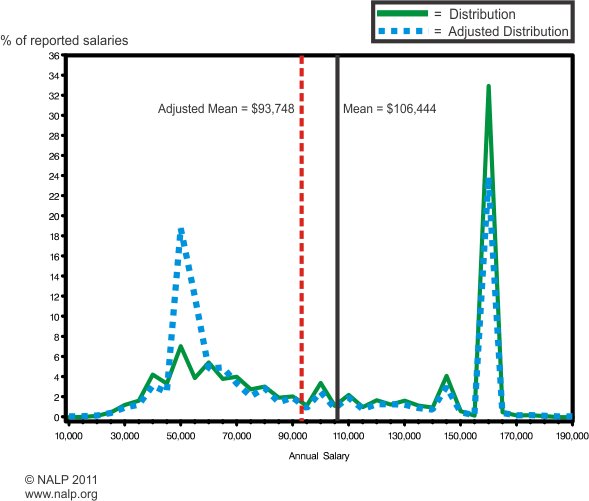August 2011
The two peaks and deep valley of NALP’s bimodal salary curves that describe the starting salaries of new law graduates are by now familiar to industry observers. The impact of the recession has changed the look of the curve somewhat for the Class of 2010. While the beast still has two humps, the number of jobs under each peak has been redistributed so that there are now more jobs represented under the left-hand, or lower paying, peak and fewer jobs represented under the right-hand, or higher paying, peak.
NALP has just published Jobs & JDs: Employment and Salaries of New Law Graduates for the Class of 2010. Since 2006 the report has included a graphic illustration of the distribution of starting salaries for new law school graduates, a dramatic bimodal curve illustrating that very few salaries are near the mean or median salary, and instead cluster at higher and lower amounts. This year’s curve continues this pattern. However, because of the shift away from law firm jobs in general and from large firms in particular (see earlier NALP press releases on the Class of 2010 at www.nalp.org/pressreleases) not only have the mean and median salary for the Class of 2010 shifted to the left, but also the bulk under the two peaks has changed. Thus, salaries of $160,000 accounted for about 18% of reported salaries for the Class of 2010, compared with about one-quarter of reported salaries in the previous two years. Salaries in the $40,000 to $65,000 range accounted for almost half of reported salaries, compared with about 40% for the previous two classes.
The report also includes a graphic illustration of the distribution of law firm salaries. This curve appears to have a less dramatic bimodal nature. However, because salaries for most jobs in large law firms are reported, whereas salaries for fewer than half of jobs in small firms are reported, this has the effect of diminishing the left-hand peak relative to the right-hand ($160,000) peak. An estimate of what the distribution would look like if small firm salaries were reported in proportion to their prevalence among law firm jobs shows more balanced peaks, and a decidedly bimodal curve.
For historical perspective, see the salary curves for the previous classes, those of 2006 through 2009, and also a NALP Bulletin article (“Salaries for New Lawyers: How Did We Get Here?”) that traces the origin of the bimodal curve.
The comprehensive Jobs & JDs report is the only one of its kind to document the employment and earnings of new law school graduates. Besides the national employment and salary figures, the full report features many other analyses, such as employment profiles for every state and major cities; details on the kinds of jobs and salaries within employment sectors, e.g., business and public interest; salaries by state for different employment sectors; law firm salaries for more than 175 cities; employment outcomes by graduate demographics; how and when graduates get jobs; and more.
Distribution of Reported Full-Time Salaries

Note: The graph above is based on 18,398 salaries. A few salaries above $200,000 are excluded for clarity. The left-hand peaks of the graph reflect salaries of $40,000 to $65,000, which collectively accounted for about 48% of reported salaries. The right-hand peak shows that salaries of $160,000 accounted for about 18% of reported salaries. However, more complete salary coverage for jobs at large law firms heightens this peak and diminishes the left-hand peaks — and shows that the unadjusted mean overstates the average starting salary by about 9%. Nonetheless, as both the arithmetic mean and the adjusted mean show, relatively few salaries are close to either mean figure. For purposes of this graph, all reported salaries were rounded to the nearest $5,000.
Distribution of Reported Full-Time Law Firm Salaries with Adjusted Distribution Also Shown

Note: The graph above is based on 10,262 reported salaries; a few salaries above $190,000 are excluded for clarity. The adjusted distribution (dotted gray line) shows that the unadjusted mean overstates the average starting salary by about 13%.